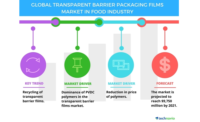Technavio’s (technavio.com) latest report on the global secondary packaging market provides an analysis of the most important trends expected to impact the market outlook from 2017-2021.
The global secondary packaging market is set to witness exponential growth during the forecast period. The nature of the materials used to make such packaging is flexible. This attribute is essential for creating shelf-ready packaging of various shapes and sizes. Different types of packaging add to the aesthetic appeal of products, resulting in attracting prospective customers. Companies such as Amazon require carrying out extensive secondary packaging. As a result, they have also automated their secondary packaging process. This reduces wastage of materials, cost of labor, and time used to pack.
The top three emerging trends driving the global secondary packaging market according to Technavio research analysts are:
- Increasing number of automation for secondary packaging
- Rising integration of distribution and packaging activities
- Advent of biodegradable plastic
“Companies have predefined 3-4 fixed standard secondary packaging dimensions in which they can fit their primary products of different shapes and sizes. Many times, it so happens that because of the predefined shapes and sizes of the secondary packaging, there is space left for more products,” says Sharan Raj, a lead analyst at Technavio for research on packaging.
In May 2015, in the U.K., the U.S. and Germany, companies such as Amazon, which handle different shapes and sizes of products, have installed nearly 25 new automation machines for secondary packaging. These machines are supposed to make around 10 to 15 boxes per minute from fan-folded corrugated boards, based on the need. These machines can custom make secondary packaging boxes depending on the product being shipped.
“Companies are now outsourcing the packaging to third-party logistics. The packaging of products is carried out at warehouses or distribution level. It is estimated that combining certain activities such as secondary packaging and distribution functions can reduce warehousing, packaging, and freight associated cost by around 30%,” adds Sharan.
Packaging products together, for the transit, is time-consuming and require resources such as manpower and space. Companies add to the extra step between the manufacturing and the DC by outsourcing the packaging.
In the present scenario, new products are being innovated in every field. These products are mostly environmental-friendly. They do not put a strain on natural resources. At present, there is an ongoing trend of using biodegradable plastics. These biodegradable plastics are easily decomposed when disposed of in the environment. Microorganisms can easily act on these plastics and speed the process of biodegradation. Therefore, these materials do not cause any harm to the environment as compared with that by traditional plastics that are not.



